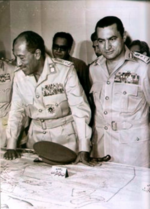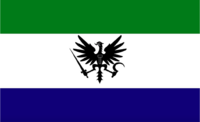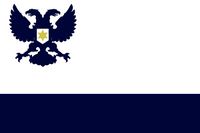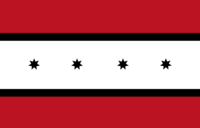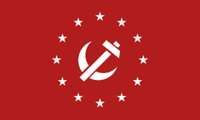Călăneasan Offensive
| Călăneasan Offensive | |||||||
|---|---|---|---|---|---|---|---|
| Part of the South Ecros War | |||||||
 Pavulturilori Mountaineers marching to the Second Battle of the Khermon | |||||||
| |||||||
| Belligerents | |||||||
| Commanders and leaders | |||||||
| Strength | |||||||
|
| ||||||
| Casualties and losses | |||||||
| ~82,000 | ~73,000 | ||||||
The Călăneasan Offensive (Illyrian Iberic: Ofensjvo de Çalanaesa, Pavulturilori: Ofensiva Călăneasan, Hebrew: המתקפה על קלנסה) [note 1], also sometimes referred to as the Third Călăneasan War (Illyrian Iberic: Terçia Guera de Çalanaesa, Pavulturilori: Al Treilea Război Călăneasan, Hebrew: מלחמת קלנסה השלישית) [note 2] was a war theater of the South Ecros War that was contested by Pavulturilor and the communist forces of New Illyricum and Terranihil from January 16, 1946, to August 2, 1948.
Following the invasion of Alaia by Pavulturilori troops in December 1945, New Illyrian Marshall of War Araeno Dofo and Terranilian President Enkart Vaslast devised an offensive into Călăneasa in northwest Pavulturilor. Facing pressure from Jackson on the Jack River and Eleutherios at Oikos, Terranihil could not sustain a third front in Alaia and needed to gain swift victory in Călăneasa.
Contents
Background
Ashura Revolution
In 1929 in Terranihil, Prime Minister Umar Šam was deposed by President Amen Tǎzma who over the next decade used various tactics, including restructuring the constitution in order to keep the Liberal Democratic Party (PĐL) in power. Feelings of revolution began to spread throughout the army in 1936, and on March 26, 1937, led by communist Enkart Vaslast and republican Karam Šaıa, the Ashura Revolution began. Revolutionary forces arrested Prime Minister Razǎnem Deperzla at Minaltar three days later, forcing Amen Tǎzma to flee the country to Quebecshire.
Revolutionary leaders established the Revolutionary Command Committee after taking power in early April, which consisted of a total of ten representatives, four communist, three republican, and three independent. However Šaıa and Vaslast soon were at odds, with Šaıa seeking to ultimately disband the Committee, and Vaslast hoping to use the Committee as a communist power platform. Šaıa took the initiative and named himself interim president on April 2, and just twenty-four days later communist forces forced Šaıa to resign from his position. On April 26, Vaslast declared himself president, and said that he would serve until the 1938 election. After the election of Amelius Fakraš in 1937, the communist Terranilian government began to systematically remove republican opposition, arresting Šaıa and taking full control of the country.
1942 Commintern World Congress
In August 1942, Communist International held its eighth World Congress at Minaltar, where communist leaders from Ajakanistan, New Illyricum, The Eisley, Creeperopolis, and Terranihil met. Leaders Leonid Petrov of Ajakanistan, Polaenino Marçelo of New Illyricum, and Enkart Vaslast jointly planned the communist takeover of Eleutherios and Zloveshchiy. Zaharias V, the leader of the Red Hand (Eleutherian: Κόκκινο χέρι, Iberic: Kókkino chéri), the communist force in Eleutherios, worked with the communist leaders and proposed the the Lighting Strike Plan (Eleutherian: Σχέδιο απεργίας φωτισμού, Iberic: Schédio apergías fotismoú). The plan was shot down by Commintern leadership due to the fact that there were other more pressing international fronts, in Zloveshchiy and Creeperopolis, however it laid the framework for a future communist takeover in Eleutherios.
Eleutherian Civil War
After several years of waiting and preparation, in 1944 Zaharias V and the Red Hand had built a significant power base in the southern Eleutherian city of Marathon and using supplies and weapons transported across the border from Terranihil they had a well equipped force in the city. On April 13, the Red Hand launched their coup, most Federalist troops had been withdrawn from the city in the proceeding days and the remaining troops were ill-equipped and unreliable. Communist troops took the city in just one day, and they quickly prepared to advance on. Federalist troops, led by Monatos IX, were slow to respond, and lacked the training and manpower to counter the growing ranks of the Red Hand.
Due to the slow response from the Federalist government, communist troops quickly moved on the attack. Federalist forces managed to form a defensive line outside of Erimos in early June and halted the communist advance. Despite numerical and supply advantages, the Red Hand was unable to take the city because of the stalwart defense of the Eleutherian troops. After four months of hard fighting, the resolve of the communists was beginning to falter, as the Federalist troops had seemed to completely stop the Red Hand. However in October, the exhausted troops of the 91st Platoon, who held a vital fort just outside of Erimos, defected to the Red Hand, handing over the important fort and its artillery to the communists. The Red Hand then used these artillery to bombard the city, which, along with a shipment of supplies from Terranihil, forced all Eleutherian troops to withdraw from Erimos by December 11.
Zaharias V and the Red Hand pushed onwards towards Corinth, which stood just 32 kilometres (20 mi) from the capital of Oikos. Federal Chancellor Kairakos VII ordered the removal of Monatos IX from his command of the Federalist forces, replacing him with Dimitrios II in early January, 1945. Federalist troops were inspired by the change in leadership, and in addition large amounts of supplies from Jackson had arrived, including weapons, food, and artillery pieces. Federalist troops commenced a counter-offensive on January 11, driving the communist forces away from Corinth and the capital towards Erimos. Panicked communist forces began to desert in droves, forcing Zaharias V to petition for Terranihil to join the war. Terranilian officials decided after a short period of deliberation to join the Red Hand and Terranilian troops invaded on February 3 beginning the full scale South Ecros War.
Pavulturilor
At the outbreak of the South Ecros War, the Kingdom of Pavulturilor, headed by King Alram Melekh X, and later on transitioning to Menakhem Melekh VI sought a hawkish expansionist and anti-communist policy, seeking to expand Pavulturilor and its borders, such as in the Mitten War, and to prosecute communism wherever possible, such as sending the Foreign Volunteer Army of Pavulturilor to fight in the Creeperian Civil War on the side of the Imperial Council.
Observing the Eleutherian Civil War, the Kingdom of Pavulturilor began to gather up forces along the Terranilian border in anticipation, of the Terranilian aid to the Red Hand to change to full military support, which indeed came in the form of the Terranilian invasion of Eleutherious, which served as the perfect opportunity to both expand the kingdom's realm, and to potentially eliminate the communist threat that lays to its north, and so on 10:00 7 December 1945, King Menakhem Melekh VI declared war on Terranihil, citing its aggression on multiple fronts, notably the Jack River blockade, its involvement in the Creeperian Civil War, and the invasion of Eleutherious.
The Pavulturilori invasion of Terranilian Alaia, codenamed "Operation Recuperare" began an hour later on 11:00 when the Royal Aviation Force of Pavulturilor bombed Terranilian outposts along the border, which were assaulted afterwards by the First Royal Army. While initially Pavulturilor made impressive land gains, after the Terranilian Army diverted resources from Eleutherious to defend its territories in Alaia, the First Royal Army soon became bogged down and was unable to advance further, giving the Terranilians the initiative.
Order of battle
Pavulturilor
 Pavulturilor
Pavulturilor
 Royal Armed Forces of Pavulturilor - King Menakhem Melekh VI
Royal Armed Forces of Pavulturilor - King Menakhem Melekh VI
 Royal Pavulturilori Army - Marshal Levi Yisrael Khaguri
Royal Pavulturilori Army - Marshal Levi Yisrael Khaguri
 Royal Aviation Force of Pavulturilor - Marshal Avshalom Akhiel Ben Hashomroni
Royal Aviation Force of Pavulturilor - Marshal Avshalom Akhiel Ben Hashomroni
 Royal Pavulturilori Navy - Marshal Roei Greenberg-Hashalit
Royal Pavulturilori Navy - Marshal Roei Greenberg-Hashalit
- Pavulturilori Romanyan Fleet - Grand Admiral - Noam Katzennelson
- VRP Yerikho - Fast Battleship, Flagship
- VRP tbd - Heavy Cruiser
- VRP tbd - Heavy Cruiser
- VRP tbd - Light Cruiser
- VRP Shalit - Destroyer
- VRP Nagad - Destroyer
- VRP Nasikh - Destroyer
- VRP Domnitor - Destroyer
- VRP Maestru - Destroyer
- VRP Bandit - Frigate
- VRP Oştean - Frigate
- VRP Navă Militară - Frigate
- VRP Soldat - Frigate
- VRP Zărnecuta - Protected Cruiser
- VRP Tirat E'emmek - Protected Cruiser
- VRP Tirat Rama - Protected Cruiser
- 2nd Gunboat Flotila
- Pavulturilori Romanyan Fleet - Grand Admiral - Noam Katzennelson
Commintern
 Terranihil
Terranihil
 New Illyricum
New Illyricum
 New Illyrian Armed Forces - Marshall Araeno Dofo
New Illyrian Armed Forces - Marshall Araeno Dofo
 New Illyrian Army
New Illyrian Army
- First New Illyrian Army - High General Manuçeo Gatelo (after August 1946) ; General Poleo Sano (until August 1946)[note 3]
- Second New Illyrian Army - General Marco Estolo
- New Illyrian Foreign Army - Grand General Marçelo Ponto
 New Illyrian Air Force - High Marshall Dorendo Monocolo
New Illyrian Air Force - High Marshall Dorendo Monocolo New Illyrian Navy - Marshall Marçelo Puno
New Illyrian Navy - Marshall Marçelo Puno
 First Attack Fleet - Admiral Juleo Poroneo, Admiral Oçolo Quesetoedo [note 4]
First Attack Fleet - Admiral Juleo Poroneo, Admiral Oçolo Quesetoedo [note 4]
- NIS Maenefeco - Battleship, Flagship
- NIS Tudino - Heavy Cruiser
- NIS Napelae - Light Cruiser
- NIS Gaelici - Light Cruiser
- NIS Araeno Faeo - Destroyer
- NIS Luçeo Alo - Destroyer
- NIS Tito Moçeo - Destroyer
- NIS Luçeo Alo - Destroyer
 The Eisley
The Eisley
Engagements
Bombing of Călăneasa

New Illyrian High Marshall of the Air Force Dorendo Monocolo organized a joint series of bombing attacks on Călăneasa, utilizing New Illyricum’s heavy bombers to damage Pavulturilori factories and military bases. Pavulturilori Marshal Avshalom Akhiel Ben Hashomroni led the Royal Pavulturilori Aviation Force’s defense of the region. Bombing began on January 16, 1946, and fighting continued for over two months into mid-March.
Despite ferocious Pavulturilori defense, the combined communist force began to overwhelm Pavulturilori aircraft, with communist bombers laying waste to industrial towns throughout the region. Communist aircraft got as far south as Zărnecuta in early March, and scores of Pavulturilori citizens were killed throughout the air raids. Despite repeated appeals for aid from their allies, Pavulturilor was unable to receive aid due to their isolation from their allies. Aerial fighting mostly ended around March 20, as the ground assaults began on the borders. In the end 12,155 Pavulturilori citizens [note 5] were killed and much damage was done to factories throughout the region, however the communist forces lost valuable aircraft in the combat, which is considered by most historians to have been a communist victory.
Battles of the Khermon
Following the inability of the Royal Aviation Force of Pavulturilor to simultaneously defend Călăneasa and conduct offensive operations in Alaia at the same time, Pavulturilori high command decided to focus its efforts on the Alaian Front and leave the skies of Călăneasa empty, this decision would embolden the New Illyrian Armed Forces to go on the offensive through the Khermon mountain range.

First Battle of the Khermon
On March 30, the First New Illyrian Army advanced on the Khermon mountain range in hopes of quickly capturing the range, utilizing engineers to blow holes in the Pavulturilori fortification and to then flood the openings with combined arms. However they were met with deadly ambushes by elite Pavulturilori mountaineers that utilized convoy distruption and guerrilla tactics to drive them back and buy more time for the defenders to dig in further. By early May, the First New Illyrian Army was routed back the mountains to regroup and prepare for another offensive.
Second Battle of the Khermon
By early August, the First New Illyrian Army once more embarked on an offensive up the mountain range, this time by shelling their advancing routes prior to ascending the mountain, this resulted in the near-complete destruction of the Pavulturilori mountaineer units stationed there. However is also made their advance much more visible for the Pavulturilori defenders who responded with artillery fire of their own on the advancing Illyrians.
Third Battle of the Khermon
The front quieted down for some time, with the New Illyrian National Military Council formulating a new plan for the assault on the Khermon. First Army commander Manuçeo Gatelo met with Terranilian command leaders and the two groups decided to organize a joint military campaign to take pressure off of the spread thin Terranilian force. On October 19, Terranilian troops launched several large assaults into Alaia and began to drive Pavulturilori forces back. While Pavulturilor diverted large amounts of resources to counter the offensive, New Illyrian forces made another assault on the Khermon.
On October 30, the New Illyrian First Army launched a quick assault into the mountains, cutting through the stretched thin Pavulturilori defenses, threatening to break through the Khermon and force the Pavulturilori force down from the mountains by December 8. However a three day long stand by the 23rd Royal Riflery Division and the Royal Mountaineers at ____ delayed the New Illyrian advance long enough to allow for reinforcements to arrive from Călăneasa. These reinforcements managed to allow Pavulturilori troops to hold the line against the New Illyrian assault. The battle ended in early January, 1947, after continued failure to gain major ground in the mountains.
Fourth Battle of the Khermon
Four months after their defeat in the Third Battle of the Khermon, on the night of the 23-24 May, New Illyrian forces attacked Pavulturilori fortifications all across the Khermon in cover of darkness, this allowed them to get exceptionally close to the Pavultrilori positions and storm the fortifications from close range and establish a foothold. At dawn the New Illyrian forces received further reinforcements with which they advanced up the mountain in brutal close-quarters combat. By May 30, the Pavulturilori forces were routed from the Khermon and retreated into a secondary defensive line 60 kilometres (37 mi) west of the city of Zărnecuta.
Battle of the Romanyan Sea
With the Jackian Navy being mostly tied up in Lake Manal and the Jack River, in the wake of their army's defeat at the Third Battle of the Khermon in early January, the New Illyrian Navy embarked on a journey to the Romanyan Sea in order to land upon Pavulturilori shores and open another front, thus diverting resources from Călăneasa allowing for an easier capture of it by the army, managing to escape Jackian patrols, the New Illyrian Navy managed to get out of the Andalzuzian Sea and into the Romanyan Sea with little to no trouble, arriving at the Romanyan Sea after just a month of sailing on 2 February, where they were spotted by a Pavulturilori patrol flight consisting of 4 sea patrol planes, of which one was successfully shot down, while the other three managed to escape and alert Pavulturilori High command, which hastily mobilized the Pavulturilori Romanyan Fleet to meet them in open sea.
On 8 February at 02:00 in the morning the opening salvo of the battle was fired by the Pavulturilori flagship, the VRP Yerikho which managed to detect the New Illyrian ships with its advanced fire control radar array, hitting the New Illyrian flagship, the NIS Maenefeceo with all of its 8 main battery guns, the rest of the Pavulturilori ships needed to sail further forward in order to fire their guns accurately, while the Illyrian ships managed to detected them and return fire, sinking the protected cruiser VRP Zărnecuta and destroyer VRP Nagad, when in range, the VRP Oştean and VRP Soldat sunk the NIS Gaelici, while the NIS Tito Moçeo managed to sink the VRP Navă Militară. Further into the battle, the New Illyrian flagship, the NIS Maenefeceo fired several full broadside salvos at the VRP Tirat E'emmek, hitting it critically, which emboldened the ships commander, Captain Avraham Meshulami to order the ship to ram it, causing heavy damage and a short firefight to take place abored the now joint two ships. This manuver would slow down the Maenefeceo significantly, allowing the Yerikho to hit it, and after several salvos, the Maenefeceo's munition storage was hit, causing a violent explosion that split the ship into two, and sent it sink rapidly.
Following the sinking of their flagship, the remaining Illyrian ships withdrew on orders of the second in command Admiral Oçolo Quesetoedo, while trying to disengaging, the Yerikho took several more salvos at the retreating ships, however, its main fire control radar was hit in a counter salvo by the NIS Tudino, making it miss its shells completely, the battle ended on the direct orders of Marshal Roei Greenberg-Hashalit to not pursue the enemy ships.
Battle for Zărnecuta

Communist forces began advancing towards the defensive line, and on June 11 began to engage Pavulturilori troops around the town of Cergău. Pavulturilori troops had prepared the line for an assault, and had stockpiled weapons and troops across it, however heavy assaults from New Illyrian troops, especially the Second Army led by General Marco Estolo, led to fracturing in the front. New Illyrian troops broke through Cergău in late June, which lay on the Zărnecuta River just 44 kilometres (27 mi) upstream of Zărnecuta itself. Pavulturilori Marshal Levi Yisrael Khaguri ordered the withdrawal of all Pavulturilori troops to Zărnecuta on July 9, as well as organizing the destruction of all major railways and infrastructure in order to slow the New Illyrian advance. Because of this plan, and because of heavy rains, New Illyrian command struggled to maintain the line, and exhausted Illyrian troops began to lose faith in the offensive.
The 8th Artillery began shelling Zărnecuta on July 25, however heavy rains and several failed forays into the city discouraged New Illyrian command from launching a full assault. On July 30, the 22nd Pavulturilori Royal Riflery Division captured an Illyrian convoy, which demoralized the weary New Illyrian troops. New Illyrian Colonel Poleo Tolo knew that the troops were on the brink of collapse, and he decided to organize a night raid on August 5. Poleo and the 1st Lancers Division led a night attack, the troops came upon a supplies depot in the north of the city, which at the time was unattended, and looted it before destroying the building.
Invigorated by the successful assault, Illyrian troops launched a full scale assault of the city of August 11, with heavy air support. The Illyrian 6th and 7th divisions made the most headway, advancing down from the hills just north of the city into the industrial district, however the 11th division, from the New Illyrian Foreign Army, suffered heavy casualties northeast of the city near Câmpina and was forced to withdraw back north by August 22. Pavulturilori General Elihau Menashe IIX realized the grave situation the Pavulturilori troops were in, especially in the northern part of the city, and attempted to lead a counter-assault in late August. However the operation failed to gain headway due to heavy Illyrian artillery fire, and Zărnecuta soon fell into deadlock.
Deadlock continued for two months, neither side was able to make progress, and with the monsoon season coming neither side was eager to continue the fighting. New Illyrian troops were especially tense, with Terranihil losing land to Jackson and with Leftist International Ciskei being defeated in the Kei River War the communist forces were in dire need of a large victory. The New Illyrian National Military Council met on November 12, and decided to organize a new attack on the city. This route instead used the western town of Huși to come at the southern section of Zărnecuta. The new attack commenced on November 20, however like previous assaults it became bogged down just west of the city at Huși because of strong Pavulturilori resistance. Due to the heavy rains and continued deadlock, New Illyrian troops began to pull out of the city with hope to regroup northwest and resupply. New Illyrian troops fully withdrew by January 15, and the assault was considered by the National Military Council to be a massive failure. Over ______ Illyrians died in the battle, and Pavulturilori troops emerged victorious and on the counter-offensive.
Marshal Khaguri's counter-offensive
With the successful defense of the city, Marshal Khaguri met with his generals to discuss a counter offensive to drive communist forces out of Pavulturilori soil, this offensive would see the use of new weapons and tactics by the Royal Pavulturilori Army, namely the PMU-47 light machine gun and Skeiðdreki IV tanks that were diverted from the Alaian Front, initially named "Operation Mania Domnului, later changed to "Operation Drept și Sfânt", the operation would start on the night of 1 February 1948 with a massive artillery barrage of Illyrian lines in tandem with an armored charge led by the 35th Royal Armored Division.

By 6 February 1948 the Pavulturilori forces had reclaimed the Dacia Line, by 22 February the Communist forces were driven back, with their backs against the Khermon mountain range, Marshall Araeno Dofo ordered a withdrawal of all Illyrian forces up the mountain range to regroup for another offensive, however the Pavulturilori forces managed to catch up to the retreating Illyrians and forced them down the mountains and back to New Illyricum, aside from low intensity skirmishes, this front would remain quite for the rest of the war.
Operation Sus și Peste
Following the Battle of Codști, Pavulturilori High command sought on press on the offensive against New Illyricum as a result of the recent successes in the front, and to "Take the fight to them"[note 6], and so on the night of 1 April 1948 the Second and Third royal armies descended down the mountains onto the Illyrian positions that were hastily dug up, after several days of bombardment the line was breached on 8 of April by the 35th Royal Armoured Division, the breach would cause the New Illyrian National Military Council to order a general retreat further into the country, this would embolden the Pavulturiolrians to push further.
Siege of Italus
On 19 April 1948 the first Pavulturilori forces have reached the outskirts of Italus, but due to the fact they were outnumbered by the city's garrison, which was bolstered by the retreating Illyrian forces, the Pavulturilorians halted their advance until further reinforcements would arrive, however the help would come too late as the siege would be lifted after 3 months of the 29 of July by an Illyrian counter-charge, this new momentum would inspire Illyrian soldiers all across the front to commit to one final push.
Operation Savannah împinge
While parts of the Second Royal Army were tied up at Italus, the Third Royal Army and the rest of the Second pushed through the southern regions of New Illyricum in order to capture the Socialist Republic of The Eisley, while initially gaining land by capturing the city of Alo Rio, however tries to capture its capital of Marinicum had failed around the same time as the Siege of Italus and led to the collapse of the front.
Operation Nu și Inch
Observing the Illyrian advance, Pavulturilori High Command would order a retreat to a defensive line inside of New Illyricum and hold ground there, however the Illyrian-led counter charge was too swift and did not allow Pavulturilori forces to set up their positions efficiently and were given the order to retreat back to the Khermon after just a few days of fighting.[note 7]
While there were attempts by several generals to commit to a secondary push, however the negotiations were already nearing their end and the Treaty of Lavignole came into effect shortly after, ending the war.
Aftermath
Progressive Terranihil
Following the Terranilian failure in both the South Ecros War and their loss in the Creeperian Civil War, Enkart Vaslast began to lose hold on Terranihil, which was also in part due to their inclusive ethnic and religious policies. Former communist party member Žapre Virǎt came to disagree with the party's policies, and left the party to develop a new ideology of national progressivism, which soon gained a following in the Terranilian Armed Forces. In 1949 communist officials arrest Virǎt and tried to purge the Marzat network, the main National Progressivist Organization, however their attempts failed and progressivism continued to gain power. On May 12, members of the Marzat network, chiefly Arkašter Emvǎran. took control of the government, arresting key communist party members such as President Enkart Vaslast and establishing the Progressive Command Committee. Due to heavy communist resistance, Arkašter Emvǎran, who had declared himself president, led large scale removals of political opponents and took main control over the nation.
Progressive leaders continued the policy of political pluralism which had been instituted by the former communist government, allowing the Communist Party and Republican Party to operate in opposition to the Progressive government. These policies however contributed to the large scale ethnic tensions throughout the nation and started The Troubles. The Troubles also stemmed from long religious conflicts and the new Sentanist policies which stressed a belief Vaktrian ethnic superiority. Several militarist left-wing groups such as Praxis Harp, and the Communist Revolutionary Army operated in western Terranihil, along with the Kavardan guerrilla Kavardan Defense Forces (MTZ) which formed in 1955 with the goal of gaining Kavardan independence. The Aramean War began in 1964 when the Aramean Independence Movement, led by the Aramean Liberation Army (SBA), began engaging Terranilian troops around Valeriana in the Pytabia governorate. Terranilian air supremacy eliminated most Aramean bases and the war would end in 1968 with the end of the movement.
Vanocan War
Following the Treaty of Lavignole, New Illyricum and The Eisley were forced to pay heavy war reparations and both nations struggled to cope with the fallout of the war. Already heavily struggling, The Eisley was forced to take out numerous loans from New Illyricum, who in turn took out loans from Terranihil and Montesayette. New Illyricum was eventually able to pay off these loans in 1951 as their economy recovered and began continuing its pre-war international exports and trade, however The Eisley fell into disrepair and was unable to pay off its loans. In the 1953 The Eisley presidential election, Independent candidate Jano Vanoco was elected over Vanguardist Party candidate Luceo Saraneo, and Vanoco made it publicly clear throughout his campaign that he did not plan to maintain The Eisley's long reliance on New Illyricum, highlighted by his campaign slogan "Elo non vaet contenoar!" (Jackian: It shall not continue). Vanoco disregarded the loans, which, while it enraged Grand Marshall Aleph Marciunjauskas, was not against the original agreements, as the loans were required to be paid off by July 10, 1955. Under Vanoco's leadership all New Illyrian troops and police were removed from the nation, and his policy of no reliance on New Illyricum lead to massive economic failure. After an attempt on his life in March of 1954 and after a failed impeachment by opposition leader Saraneo, Vanoco led a coup. Vanoco suspended the Congress of The Eisley and tried to arrest Saraneo, who escaped along with many supporters into New Illyricum. Marinicum and The Eisley erupted into civil war between Vanoco and New Illyricum backed Saraneo. The civil war raged until February 1956, when after several weeks of fighting in Marinicum, Vanocan troops were on the verge of defeat, and Vanoco committed suicide to avoid being captured by Saraneo. In an address on March 11, Marciunjauskas announced New Illyricum's formal annexation of The Eisley, which became fully incorporated into the union as The Eisley SS on July 28.
Khermon War
Following the annexation of The Eisley, small scale conflicts began to arise in the Khermon mountains between Pavulturilor and New Illyricum. Pavulturilori officials had declared the annexation to be "an illegal land grab meant to destabilize southern Ecros" and both sides of the conflicts authorized small scale attacks across the borders. In March, 1959, conflict increased along the border when a Pavulturilori missile strike hit the city of Nyapthus, prompting New Illyrian troops to launch several assaults into the Khermon mountains. Throughout the war few large assaults were made, and by 1962 the conflict had mostly abated, which led New Illyrian and Pavulturilori leaders to sign the Nyapthus Agreement. The agreement reestablished the borders set out in the previous September Agreement, which had been signed after the Second Călăneasan War, as well as forcing Pavulturilor to acknowledge New Illyrian sovereignty over The Eisley and ordering New Illyricum to pay reparations [note 8] for the events of the Khermon War.
Legacy
Cultural Impact
Art
Film and television
Litrature
Music
In pop culture
See Also
Notes
- ↑ Illyrian Iberic: [offenˈʃj'vɔ ˈdɛ 'salanaɪʃa], Pavulturilori: [ofensiva ˈkələne̯asan]
- ↑ Illyrian Iberic: ['tɛrsia 'geːra 'de 'salanaɪʃa], Pavulturilori: [al ˈtrej.le̯a rəzˈboj ˈkələne̯asan]
- ↑ General Poleo Sano led the First New Illyrian Army until he was relieved in August 1946 and replaced by Manuçeo Gatelo
- ↑ Admiral Juleo Poroneo was killed at the First Battle of the Romanyan Sea and was succeeded Admiral Oçolo Quesetoedo
- ↑ This figure has been doubted by several historians, including Ecelo Çalmo claiming that it was "a gross overestimate made by Pavulturilori officials to incriminate communist forces" in his book, De Gero Çalanaeso
- ↑ The phrase "Du-le Lupta" was a common sight in Pavulturilori propaganda posters of the time
- ↑ The failure of the "second phase" of Khaguri's Counter Offensive is often attributed to hostile terrain that hadn't allowed for sufficient supplies to reach the overextended frontline coupled with partisan attacks
- ↑ Due to a monetary crisis, New Illyricum was unable to pay the reparations and instead ceded small sections of land in Uralis SS and Italia Orientalis SS to Pavulturilor in 1965.



